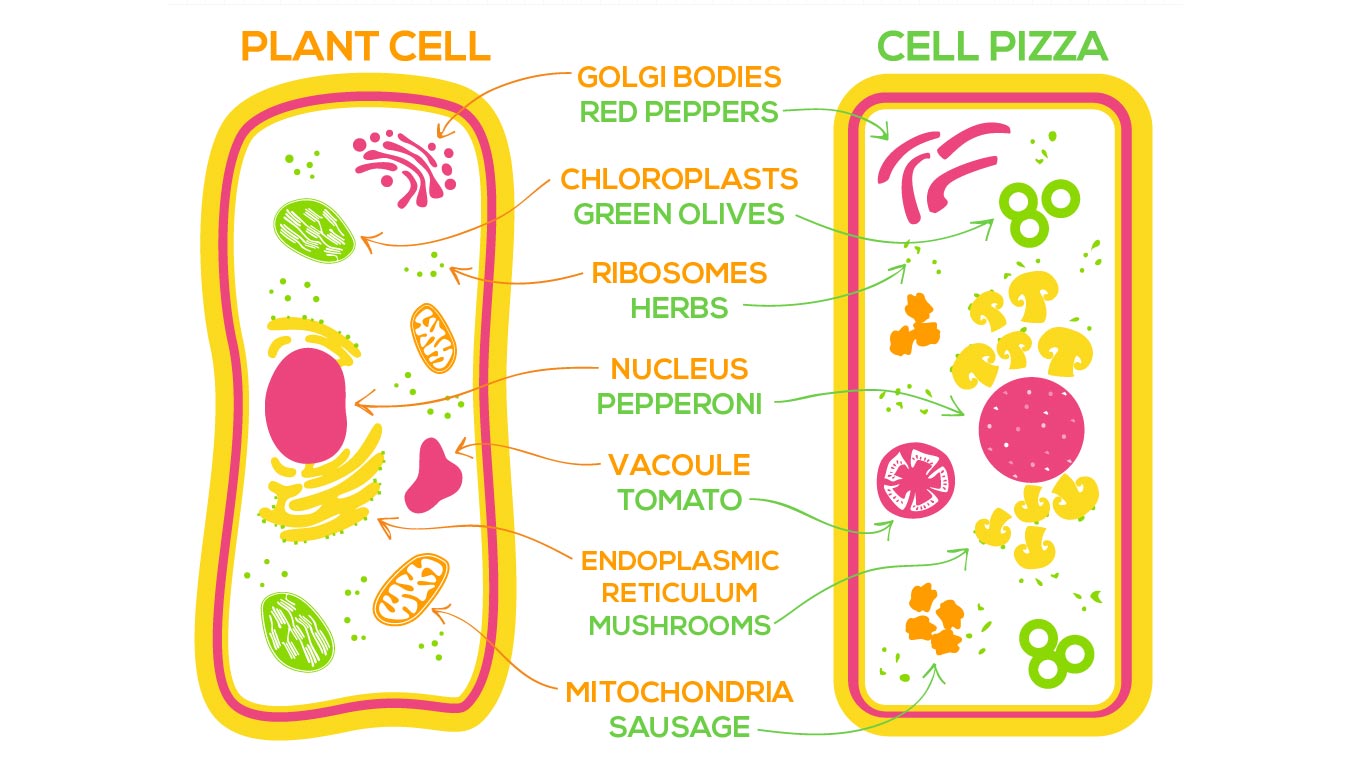
Homemade Plant Cell Pizza Recipe
All living things are made of tiny building blocks called cells. Yes, even you. You’re made of billions or maybe trillions of tiny pieces that come in all different varieties, as is almost everything you have ever eaten. Fried chicken? Cells. Cheeseburger? Cells in the meat and the bun. Veggies? Cells all the way through.Since you’re so experienced at eating cells already, we thought maybe it was time for you to make a giant one, pizza style. Since lots of the ingredients are also made of cells, once this pizza is done you can eat a cell while you’re eating cells (take that, Xzibit!).
Even though there are all different kinds of cells in all different living creatures, for the most part they all have a couple of things in common. Firstly, they build protein, which is what most of the rest of your body is made of. Second, the protein-making apparatus involves lots of tiny parts called “organelles.” Our pizza dough will be the basic cell structure, and our organelles are made of toppings. Plant cells need all of these organelles to do their job, but if you don’t like those toppings you can always pick them off before you eat your pizza. Or, you know, like, be adventurous and try them.
What you need
- Refrigerated pizza dough
- Pizza sauce
- Cheese
- Red peppers
- Green olives
- Mushrooms
- Pepperoni
- Herbs
- Cherry tomato
- Sausage
What you'll do
Our team of Science Educators put together this Facebook live in 2019 to show you how to make this science experiment you can actually eat:Here's how they did it.
To create your plant cell pizza:
- Preheat oven to 350°F
- Roll out refrigerated breadstick or pizza dough into a rectangle
- Prebake your crust for 3 minutes
- Remove from oven. Allow to cool.
- Add your organelle toppings (see below)
- Cytoplasm: The cytoplasm is the jelly that surrounds all the organelles in the cell. Use sauce for your cytoplasm.
- Nucleus: Use something large and round, such as a slice of tomato, eggplant, ham, or salami for your nucleus. The nucleus is the “control center” for the cell. The nucleus contains the chromosomes, which are made of DNA. DNA is the instruction manual for the cell to make everything the body needs. In most animal cells, the nucleus is near the center. In plant cells, the nucleus is often pushed to the side by vacuoles.
- Ribosomes: Use something small but colorful to represent ribosomes. Perhaps use minced green onions, chopped herbs, or bacon bits. Ribosomes are like little factories that make proteins for the cell. Ribosomes can be found either free in the cell, or on the rough endoplasmic reticulum. To put your ribosomes in, sprinkle a few around the cell and push them to set them in.
- Mitochondria: Bits of sausage or olive, or even black beans can represent the mitochondria in the cell. Mitochondia are often called the “powerhouse” of the cell. These organelles have their own circluar DNA and are the site of aerobic respiration, which produces ATP, the energy your cell needs to survive. These are found throughout the cell.
Golgi Bodies: Golgi bodies are a series of stacked sacs that process and package the lipids and proteins made in the cell. Try using peppers or even pineapple! They are often depicted near the nucleus, but can be anywhere in the cell. - Endoplasmic Reticulum: Or ER, is a series of tubes that carry the lipids and proteins to the cell membrane. They can be rough or smooth. Rough ER has ribosomes on it, and makes proteins and sends them to the golgi bodies for packaging. You can use sliced mushrooms or peppers for ER. Make a smooth (without ribosomes) and a rough (with ribosomes).
- Vacuole: Vacuoles contain many things: food, waste, enzymes and water. They are storage sites in the cell. Plant cells usually have large central vacuoles, while animal cells have smaller ones throughout the cell. You can use anything or even put in an empty space for the vacuole—be creative.
- Chloroplasts: Chloroplasts are only found in plant cells, so don’t use them if you’re making an animal cell! Chloroplasts contain green pigment called chlorophyll, and are needed for photosynthesis. Photosynthesis is the process a plant uses to make food from sunlight. Use green peppers, green olives, or green onions for chloroplasts, but only in the plant cells!
- Membrane and Cell Wall: Every cell has a membrane, which acts as a skin, letting good things in and keeping bad things out. The membrane is made of fats, or lipids, and proteins. Plant cells also have a cell wall, which is stronger and thicker. You can press herbs or cheese around your crust to form the wall and membrane!
- Bake until cheese is melted and bubbly.
- Remove from oven, allow to cool.
- Cut, eat, and enjoy!









